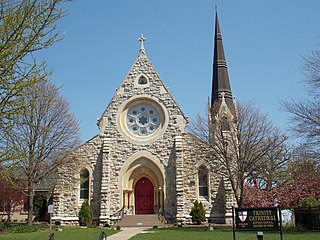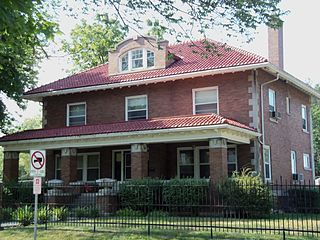
Davenport is a city in and the county seat of Scott County, Iowa, United States. Located along the Mississippi River on the eastern border of the state, it is the largest of the Quad Cities, a metropolitan area with a population of 384,324 and a combined statistical area population of 474,019, ranking as the 147th-largest MSA and 91st-largest CSA in the nation. According to the 2020 census, the city had a population of 101,724, making it Iowa's third-most populous city after Des Moines and Cedar Rapids. Davenport was founded on May 14, 1836, by Antoine Le Claire and named for his friend George Davenport.

Grinnell College is a private liberal arts college in Grinnell, Iowa, United States. It was founded in 1846 when a group of New England Congregationalists established Iowa College. It has an open curriculum, which means students may choose most of the classes they take, instead of taking a prescribed list of classes.

The Quad Cities is a region of cities in the U.S. states of Iowa and Illinois: Davenport and Bettendorf in southeastern Iowa, and Rock Island, Moline and East Moline in northwestern Illinois. These cities are the center of the Quad Cities metropolitan area, a region within the Mississippi River Valley, which as of 2013 had a population estimate of 383,781 and a Combined Statistical Area (CSA) population of 474,937, making it the 90th-largest CSA in the nation.

Bettendorf is a city in Scott County, Iowa, United States. It is the 15th largest city of Iowa and the third-largest city in the "Quad Cities". It is part of the Davenport–Moline–Rock Island, IA-IL Metropolitan Statistical Area. The population was 39,102 at the 2020 census.
Bettendorf High School (BHS) is a public four-year comprehensive high school located in Bettendorf, Iowa and is part of the Bettendorf Community School District.

Assumption High School (AHS) is a Roman Catholic high school in the Roman Catholic Diocese of Davenport in the U.S. state of Iowa. Bridget Murphy is the current principal of Assumption High.

The Village of East Davenport, also known simply as The Village, is located along the Mississippi River on the southeast side of Davenport, Iowa, United States. It was listed as a historic district on the National Register of Historic Places in 1980 as the Davenport Village. At the time of its nomination it included 145 contributing properties, most of which were working-class housing.

Trinity Episcopal Cathedral, formerly known as Grace Cathedral, is the historic cathedral in the Diocese of Iowa. The cathedral is located on the bluff overlooking Downtown Davenport, Iowa, United States. Completed in 1873, Trinity is one of the oldest cathedrals in the Episcopal Church in the United States. It was individually listed on the National Register of Historic Places in 1974. In 1983 the cathedral was included as a contributing property in the College Square Historic District, which is also listed on the National Register.

Regina Coeli Monastery is a historic building located in Bettendorf, Iowa, United States. It has been listed on the National Register of Historic Places since 1994. The building currently houses an addictions rehabilitation facility called The Abbey Center. The Discalced Carmelite nuns who built the building relocated to a new monastery in Eldridge, Iowa in 1975. The monastery was originally established in Davenport, Iowa by the Rt. Rev. James Davis of the Catholic Diocese of Davenport.

The Antoine LeClaire House is a historic building located on the east side of Davenport, Iowa, United States. It is a community center that was built as a private home by one of the founders of the city of Davenport. It also housed two of Davenport's Catholic bishops. The home was constructed in 1855. It was listed on the National Register of Historic Places in 1974, and on the Davenport Register of Historic Properties in 1992.

The Joseph W. Bettendorf House is a historic building located in Bettendorf, Iowa, United States. It has been listed on the National Register of Historic Places since 1983. Built as a private home, the building now houses a private school named Rivermont Collegiate.

St. Katherine's Historic District is located on the east side Davenport, Iowa, United States and is listed on the National Register of Historic Places. It is the location of two mansions built by two lumber barons until it became the campus of an Episcopal girls' school named St. Katharine's Hall and later as St. Katharine's School. The name was altered to St. Katharine-St. Mark's School when it became coeducational. It is currently the location of a senior living facility called St. Katherine's Living Center.

St. Luke's Hospital was a hospital building on a bluff overlooking downtown Davenport, Iowa, United States. It is listed on the Davenport Register of Historic Properties and the National Register of Historic Places. It has subsequently been torn down.

College Square Historic District is a nationally recognized historic district located on a bluff north of downtown Davenport, Iowa, United States. It was listed on the National Register of Historic Places in 1983. The district derives it name from two different colleges that were located here in the 19th century.

The Arthur Ebeling House is a historic building located on the west side of Davenport, Iowa, United States. The Colonial Revival house was designed by its original owner, Arthur Ebeling. It was built from 1912 to 1913 and it was listed on the National Register of Historic Places in 1984.

Oakdale Memorial Gardens, formerly Oakdale Cemetery, is located in east-central Davenport, Iowa. It contains a section for the burial of pets called the Love of Animals Petland. In 2015, the cemetery was listed as an historic district on the National Register of Historic Places, and as a local landmark on the Davenport Register of Historic Properties. It is also listed on the Network to Freedom, a National Park Service registry for sites associated with the Underground Railroad.

William P. Bettendorf was a German-American inventor. He is credited with the invention of the power lift sulky plow, the Bettendorf metal wheel and the one-piece railroad truck frame. By the age of 53 he held 94 patents. With his younger brother, Joseph W. Bettendorf, he founded the Bettendorf Axle Company. His first wife and children preceded him in death. He died as the company was rapidly expanding and before he moved into a palatial home he was building. The city of Bettendorf, Iowa is named after the two brothers.

Joseph W. Bettendorf was an American businessman with his brother William P. Bettendorf in Davenport and Bettendorf, Iowa. The city of Bettendorf is named after the two brothers.

Immaculate Conception Academy, known locally as ICA, was a Catholic girls' high school located in Davenport, Iowa, United States. It was begun by the Sisters of Charity of the Blessed Virgin Mary (BVM) in 1859 and it remained in operation until it merged with St. Ambrose Academy in 1958 to form Assumption High School. The academy building remains in use as an academic building on the campus of Palmer College of Chiropractic.






















